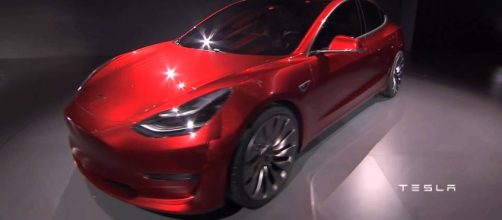Bloomberg reported catching the first glimpse of Tesla Inc's highly anticipated and much awaited Electric car, Tesla's Model 3. Entrepreneur and CEO Elon Musk unveiled the company's next offering at its plant in Fremont, California on the night of Friday, July 28th, 2017.
Two vehicles were showcased. The standard battery version priced at $35,000 (not available until Fall), whose photo Musk posted earlier in July and the long-range battery version priced at $44,000 (currently available). Both tried to fortify Tesla's status as the pioneer in manufacturing the most economically-priced Electric Cars.
Musk himself endorsed this fact by calling it "the best car in this price range, offering a great and affordable driving experience."
It is clear that Tesla's Model 3 is attempting to leverage the growing interest in electric vehicles, especially among the youth, as revealed by a fresh survey conducted and reported by the Consumer Federation of America (CFA). However, would you be willing to fork over $44,000 for a Tesla vehicle that runs 310 miles on a single charge?
What do customers want from an electric vehicle?
According to the latest report titled "Global EV Outlook 2017: Two million and counting," published by the International Energy Agency (IEA), the global electric vehicles market has a huge growth potential as evident from continually impressive figures based on the inventory and sales of electric cars over the last five years.
Despite such overall success, the annual growth rates of these zero emission vehicles (ZEV) have been on a constant decline during the same time period, with a straight 25 percent drop in sales in 2016 from 85 percent from 2014.
A recent article published in a journal titled Transport Reviews echoes this dwindling market penetration problem facing electric vehicles.
The scholarly piece, based on a detailed and comprehensive review of studies on consumer preferences for electric vehicles highlights the role of four factors pertaining to the features or attributes of a vehicle alternative, that guide its purchase decision. They are:
- Financial attributes - These are the financial aspects of purchasing and using an electric vehicle, including its purchase price, operation cost, and battery lease cost.
- Technical attributes - These denote the technical features of the electric vehicle pertaining to its overall performance, including the driving range, battery recharging time, brand diversity, and warranty.
- Infrastructure attributes - These relate to the availability of charging infrastructure for your electric vehicle.
- Policy attributes - These are the different government policy instruments available for facilitating electric vehicle adoption, such as reduced purchase tax and price, free parking, toll reduction, annual tax reduction, and giving the vehicle to high occupancy vehicle (HOV) lanes.
How warmly would Tesla's Model 3 be welcomed by the market depends on its performance on these parameters?
What Tesla's Model 3 Can or Cannot Deliver?
The more affordable version of Tesla's Model 3 is yet to be available. So, let us analyze the second expensive offering in terms of the attributes mentioned above to see its expected deliverables.
The results of a research study exploring consumer attitudes toward electric vehicle purchase intentions that appeared in a journal titled Technological Forecasting and Social Change suggest that the perceived price of an electric car and its battery charging time is inversely related to the purchasing intent.
Tesla's Model 3 has been positioned primarily as an economical driving option. The affordability factor stems from both its financial and technical attributes.
While a $44,000 price tag appears significantly lower than the company's previous two luxury offerings of Model S and Model X, each of which crossed $100,000 mark.
Technically, Tesla's Model 3 boasts superior performance in terms of covering 310 miles with a single charge, as compared to only 239 miles traveled by the existing $37,500 priced Chevy Bolt.
Regarding the availability of charging infrastructure, existing studies give more marks to the close proximity of charging stations than gas stations as it saves both time and searching cost for the consumers. In that sense, the new customers of Tesla's Model 3 can expect to be covered given a 72 per cent increase in the number of publicly accessible charging points worldwide since 2015, taking the total tally to 3,20,000 units.
Finally, the research literature elucidates the selective role of policy attributes in promoting electric vehicle adoption, based on factors such as the policy attribute preference, varying policy support extended by different countries etc.
Tesla's Model 3 is expected to gain limited acceptance in the United States, given registration tax exemptions and purchase rebates in only a few states, with mandatory production guidelines in place in only nine states.
However, in the Scandinavian world of Norway, Denmark, and Sweden, things seem to be a lot brighter. As each country is spearheading the formulation of financial policy incentives such as exemption from acquisition tax and reduction in the purchase price of electric cars, aimed at accelerating electric vehicle adoption.
Similarly, Asian countries like China and Japan are offering strong financial and non-financial incentives to facilitate high electric vehicle buying rates. These include exemption from both acquisition and excise taxes and coming up with new subsidy schemes.
Thus, even though, at a macro-level, things seem to be quite optimistic for Tesla's Model 3, I would like to take it with a pinch of salt. Since it does not factor-in the very important element of actual customer experience. The real picture will emerge once the actual car units begin to sell.
Until then I am keeping my fingers crossed.


